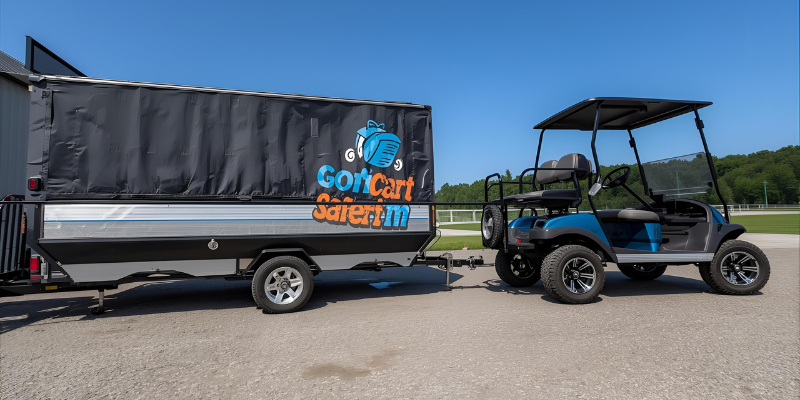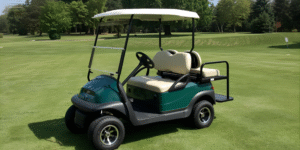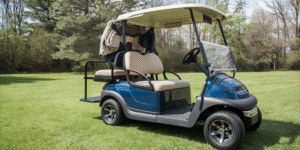Golf carts have become far more than course companions. Today, they’re used in neighborhoods, campgrounds, farms, resorts, and even as secondary vehicles. But what happens when you need to move your golf cart somewhere farther away? Driving it on the road isn’t an option, so towing it with a trailer becomes the best solution.
For new golf cart owners, towing can feel intimidating. You may wonder what trailer size you need, how to load the cart safely, and what precautions to take for the road. Done correctly, towing a golf cart is simple and secure. Done wrong, it can damage both the trailer and the cart—or worse, cause an accident.
This complete guide will walk you through everything you need to know about towing a golf cart on a trailer, from choosing the right setup to safe loading, strapping, and transporting.
Why Tow a Golf Cart on a Trailer?
There are plenty of reasons to tow instead of drive:
- Transporting your cart to a golf course far from home.
- Moving your cart to a vacation spot, campground, or resort.
- Taking a cart in for maintenance or upgrades.
- Relocating to a new home or property.
- Avoiding unnecessary wear and tear on the tires and batteries.
Towing ensures your cart arrives safely and ready to use without draining its charge.
Choosing the Right Trailer for a Golf Cart
The trailer you choose is the foundation of safe towing. Golf cart trailers come in various sizes and styles, but not every trailer will work for every cart.
Standard Trailer Sizes
- 5×8 Trailer: Works for most two-seater carts. Compact and easy to tow.
- 5×10 Trailer: Offers extra space and is suitable for four-seater carts.
- 6×10 or 6×12 Trailer: Best for lifted carts, six-seaters, or when extra room is needed.
Always measure your cart including width, length, and height before purchasing or renting a trailer.
Open vs. Enclosed Trailers
- Open Trailers: Affordable, lightweight, and easier to load. Ideal for short trips.
- Enclosed Trailers: Provide full protection from weather, theft, and road debris. Perfect for long-distance towing.
Preparing the Golf Cart for Towing
Before loading, your golf cart needs some preparation to ensure safety:
- Turn the cart off completely.
- Engage the parking brake. This prevents rolling during loading.
- Switch the cart to tow mode (if equipped) to protect the motor and controller.
- Remove loose accessories such as coolers, bags, or decorations.
- Check tire pressure to ensure stable towing.
How to Load a Golf Cart onto a Trailer
Loading is often the trickiest part of towing, but with the right method, it becomes straightforward.
Step 1: Use Proper Ramps
Never attempt to lift or drive onto a trailer without sturdy ramps. Choose ramps designed for golf carts, with a weight capacity that exceeds your cart’s total weight.
Step 2: Align the Cart and Trailer
Park directly in front of the trailer and align the cart with the ramps. This reduces the chance of slipping or misalignment.
Step 3: Drive Up Slowly
Engage the cart’s forward gear and drive slowly up the ramps. Keep a steady speed—too slow and you risk rolling back, too fast and you could overshoot.
Step 4: Center the Cart
Once on the trailer, ensure the cart is centered with even space on both sides. A balanced load prevents swaying during transport.
Securing the Golf Cart
A properly loaded cart must be secured to avoid shifting.
- Use ratchet straps rated for the cart’s weight.
- Attach straps to the frame rather than the roof supports or accessories.
- Tighten straps evenly on all four corners.
- Check tension before hitting the road.
For long trips, stop occasionally to recheck straps, as vibrations can loosen them.
Towing Safety Tips
- Always use a vehicle capable of towing the trailer weight plus the golf cart.
- Double-check your trailer’s hitch connection.
- Test lights and signals before driving.
- Drive slower than usual, especially on turns and rough roads.
- Avoid sudden braking to reduce trailer sway.
Legal Considerations
Laws for towing vary by state. Some areas require trailers to have license plates, reflectors, or specific braking systems. Check local regulations before towing your golf cart to avoid fines or complications.
Long-Distance Towing
For long trips, enclosed trailers are recommended. They provide better protection and allow you to pack accessories. If using an open trailer, consider a heavy-duty cart cover to shield against rain and dust.
Alternatives to Trailer Towing
If you don’t own a trailer, there are still options:
- Hire professional transport services that specialize in moving golf carts.
- Use a tow dolly for short distances (though not as stable as a full trailer).
- Rent a trailer from local equipment or moving companies.
Conclusion
Towing a golf cart on a trailer is easier than it seems when you know the right steps. By choosing the proper trailer size, preparing the cart, loading carefully, and securing it with quality straps, you can transport your cart safely and confidently. Whether it’s a short trip to the golf course or a long-distance move, the right preparation ensures peace of mind.
For expert help with golf cart transport, storage solutions, or setup, contact us today for professional guidance.
FAQs
What size trailer do I need for a golf cart?
Most two-seaters fit on a 5×8 trailer, while four-seaters need at least 5×10. Larger carts require 6×10 or bigger.
Can I tow a golf cart on a car trailer?
Yes, as long as the trailer dimensions and weight rating are suitable for your cart.
Should I tow my cart facing forward or backward?
Always face the cart forward unless instructed otherwise by the manufacturer.
Do I need to cover my cart when towing?
Covers are recommended for long trips, especially with open trailers, to protect against weather and debris.
Can I tow two golf carts on one trailer?
Yes, but only if the trailer is large enough (often 6×12 or bigger) and rated for the combined weight.










